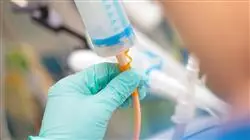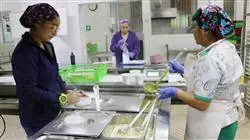
University certificate
The world's largest faculty of nursing”
Description
Qualify yourself with the best advanced master’s degreeon the market and offer your patients quality nursing care, providing all your knowledge in nutrition"

Keeping a balanced diet helps to maintain health. However, there are pathologies that demand certain dietary protocols that are more beneficial to control and help overcome disease. In this field, the work of the healthcare practitioner is essential, since having a broad knowledge of clinical nutrition will allow them to offer more personalized care to their patients.
Therefore, specialization in nutrition is the healthcare practitioner's essential response to healthcare and preventive needs of the population in terms of nutrition and health, and is especially important in the field of nursing.
In pediatric pathology, nutrition intervenes as an etiological factor and as a complication of other diseases. In the same way in geriatrics, sick patients or even athletes, the exhaustive and complete control of food becomes an essential tool in any therapeutic approach. In this scenario, the study of the human microbiota opens a door to the knowledge of multiple diseases, especially the so-called functional diseases, with the microbiome being the main workhorse of researchers.
In addition, there is ample evidence on the importance of proper nutrition for the prevention and treatment of chronic diseases, such as cardiovascular diseases, type 2 diabetes mellitus, cancer, among others, and this, together with the fact that there are more and more nutritional supplements available to users, makes it vitally important to have the necessary expertise to provide good nutritional advice.
This advanced master’s degree offers the possibility to learn in depth and update knowledge in this subject, with the use of the most up-to-date educational technology. It provides an overview of clinical nutrition, while focusing on the most important and innovative aspects of feeding in the pediatric age, as well as the diseases in which feeding plays a highly relevant role. All this in a 100% online specialization, which will allow you to expand your knowledge and, therefore, your professional skills and competencies in a simple way, adapting your study time to the rest of your daily obligations.
Keeping up to date with the latest developments in clinical nutrition will help you provide better care for your patients. Do not hesitate and increase your education in this field”
This advanced master’s degree in Clinical Nutrition for Nursing contains the most complete and up-to-date scientific program on the market. The most important features include:
- Clinical cases presented by experts in the different specialties
- The graphic, schematic, and practical contents with which they are created, provide scientific and practical information on the disciplines that are essential for professional practice
- Diagnostic and therapeutic novelties on the management of pathologies in the field of nutrition
- Presentation of practical workshops on procedures, diagnosis, and treatment techniques
- Contains real images in high resolution and practical exercises where the self-evaluation process can be carried out to improve learning
- An algorithm-based interactive learning system for decision-making in the clinical situations presented throughout the course
- Special emphasis on test-based medicine and research methodologies
- All of this will be complemented by theoretical lessons, questions to the expert, debate forums on controversial topics, and individual reflection assignments
- Content that is accessible from any fixed or portable device with an Internet connection
This program is the best investment you can make in selecting a refresher program for two reasons: in addition to updating your knowledge of advanced master’s degree, you will earn a degree from TECH Technological University"
Its teaching staff includes healthcare practitioners from the field of nutrition, who contribute their work experience to this program, as well as renowned specialists belonging to leading scientific societies.
Thanks to its multimedia content developed with the latest educational technology, it will allow the professional a situated and contextual learning, that is to say, a simulated environment that will provide an immersive learning programmed to prepare in real situations.
This program is designed around Problem-Based Learning, whereby the physician must try to solve the different professional practice situations that arise throughout the program. To do so, the physician will be assisted by an innovative interactive video system created by renowned experts in the field of Clinical Nutrition for Nursing with extensive teaching experience.
Increase your confidence in decision making by updating your knowledge through this advanced master’s degree, a program created to prepare the best"

We offer you the best teaching methodology, with a multitude of practical contents that will allow you to study in a more complete and effective way"
Objectives
This program in Clinical Nutrition for Nursing is oriented to offer a complete, detailed and up to date vision of nutritional counseling as a key element in the maintenance and improvement of the health of patients of any age and condition.

Our goal is to achieve Academic excellence and we will help you achieve it too”
General Objectives
- Develop within the profession in terms of working with other health professionals, acquiring skills to work as a team
- Recognize the need to maintain your professional skills and keep them up to date, with special emphasis on autonomous and continuous learning of new information
- Develop the capacity for critical analysis and research in your professional field
- Understand the basics of nutritional analysis in people of any age, regardless of whether they are healthy or not and in any personal circumstance
- Know the products and possibilities that can be recommended for use at home
Specific Objectives
Module 1. New Developments in Food
- Review the basics of a balanced diet in the different stages of the life cycle, as well as in exercise
- Assess and calculate nutritional requirements in health and disease at any stage of the life cycle
Module 2. Current Trends in Nutrition
- Review the new dietary guidelines, nutritional objectives, and recommended dietary allowances (RDA)
- Manage food databases and composition tables
- Explain the proper reading of new food labeling
Module 3. Probiotics, Prebiotics, Microbiota, and Health
- Deepen knowledge of how drugs designed for humans can have a negative impact on the gut microbiota, in addition to the known impact of antibiotics
- Know in depth the safety profile for probiotics, since, although their use has spread in recent years thanks to their proven efficacy, in both the treatment and prevention of certain diseases, this does not exempt them from generating adverse effects and potential risks
Module 4. Sports Nutrition
- Identify the repercussion that a pregnant and lactating mother's nutrition has on the intrauterine growth and evolution of new-borns and infants
- Describe the nutritional requirements in the different periods of childhood
- Perform nutritional assessment in pediatrics
- Evaluate and prescribe physical activity as a factor involved in nutritional status
- Calculate child and adolescent athlete dietary needs and risks
- Review current trends in premature infant nutrition
- Explain current trends in the nutrition of infants with delayed intrauterine growth and the implication of nutrition on metabolic diseases
- Reflect on the role of human milk as a functional food
- Analyze the operation of milk banks
- Describe new formulae used in infant feeding
- Reflect on new trends and models in infant feeding
Module 5. Clinical Nutrition for Nursing and Hospital Dietetics
- Reflect and identify risk factors in school and adolescent nutrition
- Incorporate the different techniques and products of basic and advanced nutritional support related to pediatric nutrition into clinical practice
- Identify children at nutritional risk who are eligible for specific support
- Evaluate and monitor the supervision of children on nutritional support
- Explain the new developments and available evidence on probiotics and prebiotics in infant feeding
Module 6. Nutrition in Digestive System Pathologies
- Identify children suffering from malnutrition
- Describe the correct nutritional support for a malnourished child
- Classify the different types of malnutrition and their impact on the developing organism
- Reflect on the etiology, repercussions, and treatment of childhood obesity
- Explain the nutritional treatment of the most common deficiency diseases in our environment
- Define the role that fats play in children’s diets
Module 7. Nutrition in Endocrine-Metabolic Diseases
- Assess the psychological and physiological aspects involved in eating disorders in young children
- Identify eating behavior disorders
- Review the pathogenesis and update the treatment of inborn errors of metabolism
- Explain the treatment of dyslipidemias and the role that nutrition plays in their genesis and treatment
Module 8. Nutrition in Special Situations
- Manage diabetic children's diet
- Assess the nutritional support of children with cancer in different situations
- Reflect on the role of nutrition in autistic children
- Review the rationale for dietary support of acute diarrhea
- Describe the management of nutritional support in inflammatory diseases
- Reflect on the relationship between constipation and infant nutrition
- Identify exclusion foods in the diets of children with celiac disease
- Define the dietary management of children with nephropathy
- Explain the latest evidence on food allergies and intolerances
- Identify dietary factors related to bone metabolism
- Review the dietary management of oral cavity pathologies in children
- Explain managing children with gastroesophageal reflux
- Explain the implications that nutrition can have in the treatment of liver diseases
- Describe the main malabsorption syndromes and how they are treated
- Identify the appropriate nutritional therapy for pediatric patients with chronic pulmonary pathology
Module 9. Nutrition in Deficiency Diseases
- Identify the main deficiency diseases that generate malnutrition in the patient
- Analyze the fasting and refeeding cycle
- Identify the foods with the highest percentage of nutrients and vitamins
- Explain the main reasons for anemia and hemochromatosis in patients with poor nutrition
- Analyze the foods that are useful in combating osteoporosis
- Identify oral diseases and their relationship to nutrition
Module 10. Artificial Nutrition in Adults
- Identify the enteral nutrition technique and delve into its mechanism of appropriation on adult patients
- Identify the parenteral nutrition technique and delve into its mechanism of appropriation on adult patients
- Analyze the process of home artificial nutrition
- Describe the process of adapted oral nutrition and its efficacy in adult patients
Module 11. Assessment of Nutritional Status and Diet. Practical Application
- Identify the role of bioenergetics in the assessment of nutritional status
- Describe the process to perform nutritional status assessment
- Learn to assess intake
- Analyze body composition
- Identify the main biochemical, hematological and immunological methods of nutritional status
- Identify new updates in nutritional requirements
- Identify the different types of diets that exist, and which one is more suitable for the different stages of life
- Identify the different types of foods and their nutritional value in order to make a proper assessment
Module 12. Nutritional Consultation
- Describe the procedure for implementing a consultation
- Identify the role of the consultation and its medical value for the patient's health
- Analyze the different forms of nutrition and define which one is more appropriate for each type of patient
Module 13. Physiology of Infant Nutrition
- Identify the nutritional status of the child patient and its rapid medical diagnosis
- Explore the main techniques that help good nutrition and implement them in the different situations of child malnutrition
- Identifying the undernourished infant
- Identify the overweight infant
- Analyze the different diseases that attack the nutritional development of the infant patient
- Develop new techniques to help improve the situation of children with nutritional problems
Module 14. Artificial Nutrition in Pediatrics
- Identify the enteral nutrition technique and delve into its mechanism of appropriation on pediatric patients
- Identify the parenteral nutrition technique and delve into its mechanism of appropriation on pediatric patients
- Analyze the process of home artificial nutrition in the pediatric patient
- Describe the process of adapted oral nutrition and its efficacy in the pediatric patient
Module 15. Infant Malnutrition
- Identify through a brief diagnosis the clinical classification of the infant patient
- Explain the problems that infant malnutrition can generate and its implication in the infant's development
- Identify vitamin and trace element deficiencies
- Analyze the process of fats in infant feeding
- Analyze the repercussions of diseases in the pediatric patient
Module 16. Childhood Nutrition and Pathologies
- Identify the child with oral pathology
- Analyze the repercussions of nutritional alterations in infants
- Identify mechanisms to prevent malnutrition in infants
- Analyze the nutrition of the child with celiac disease
- Identify the mechanisms to avoid malnutrition
- Identify the different digestive pathologies affecting infants
Module 17. Childhood Nutrition and Pathologies
- Assess the nutritional support of children with cancer in different situations
- Reflect on the role of nutrition in autistic children
- Describe the management of nutritional support in inflammatory diseases
- Define the dietary management of children with nephropathy
- Identify dietary factors related to bone metabolism
- Explain the implications that nutrition can have in the treatment of liver diseases
- Identify the appropriate nutritional therapy for pediatric patients with chronic pulmonary pathology

Get the most comprehensive update on Clinical Nutrition for Nursing through the best educational material"
Advanced Master's Degree in Clinical Nutrition for Nursing
"Tell me what you eat and I will tell you what you suffer from" says a popular aphorism. In the work of caring for the sick, delving into such words is more than crucial, because it is not just a mere saying. Medical and scientific studies show, for example, that the intestinal flora is linked to the immune system. So, if your goal is to excel as a health professional, you should not miss the Advanced Master's Degree in Clinical Nutrition for Nursing: an exclusive opportunity because it is a fully online academic program with flexible schedules and dynamic Relearning system to provide a learning experience above conventional standards. Here you will also find a very complete syllabus delving into extremely useful concepts such as probiotics, prebiotics and synbiotics, diabetes mellitus, obesity, endoscopic treatments and even nutrition in autistic children. Do not slow down your urge to learn and opt for the largest digital institution of the moment.
Study a Nursing postgraduate course on clinical nutrition.
What diet should a child with gastroesophageal reflux follow? What foods are ideal for a person undergoing chemotherapy treatment? What is nutrigenomics used for? How to nutritionally cope with a case of liver transplant or irritable colon? You will find the answers to each of these questions in the content of our Professional Master's Degree. Throughout 17 modules, each one broken down in a rigorous manner, we will train you in the advances in nutrition, approaches to food for digestive and endocrine-metabolic pathologies, hospital dietetics, nutritional assessment and counseling for pediatrics, among other highly relevant topics. The advantage of the present educational offer contrasted with similar programs is that you have access to a full range of specialized knowledge in an online format based on state-of-the-art software and clinical case studies proposed by a panel of experts. Named by Forbes as the best online university in the world, we provide you with world-class quality at the click of a button.






